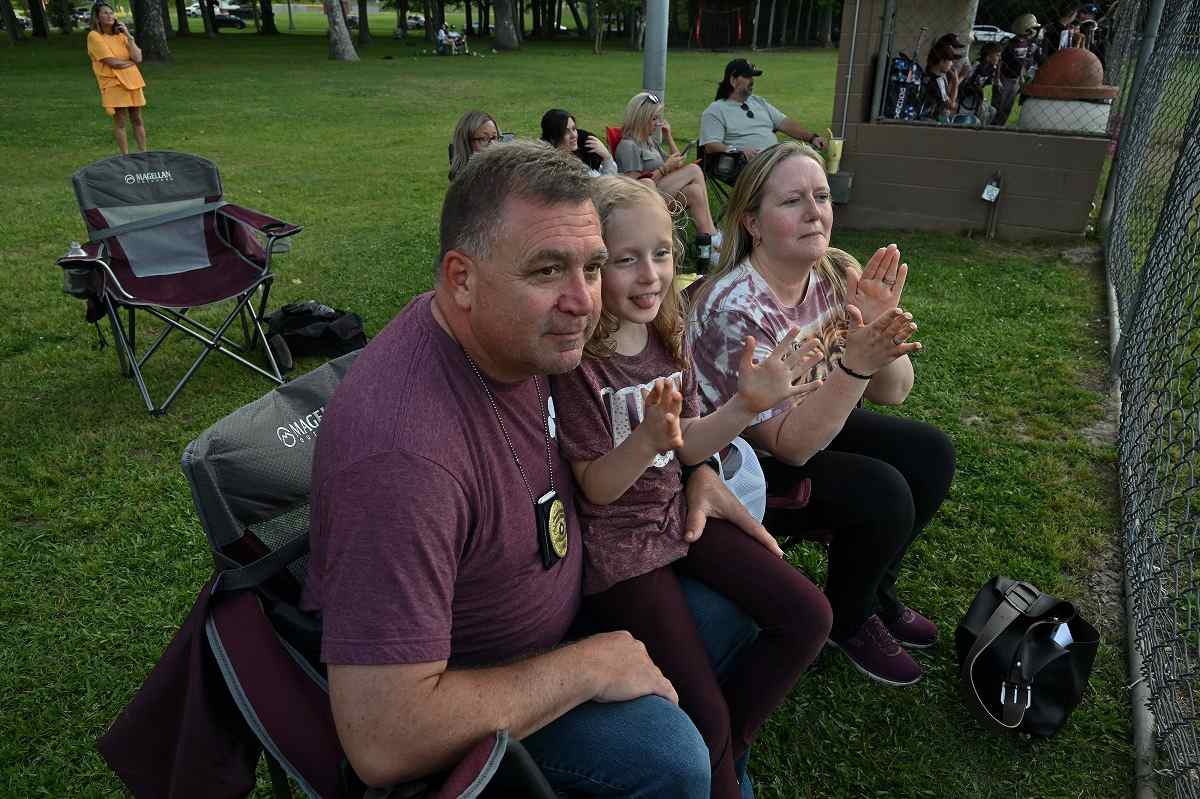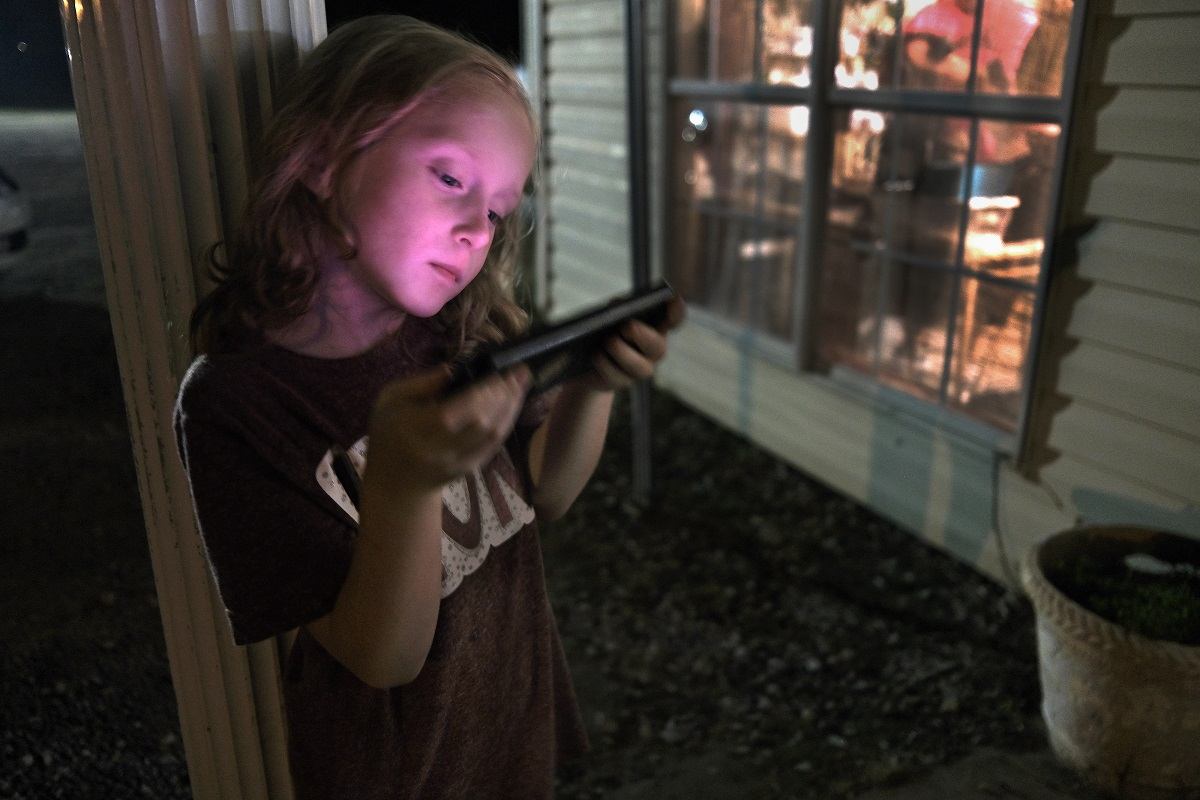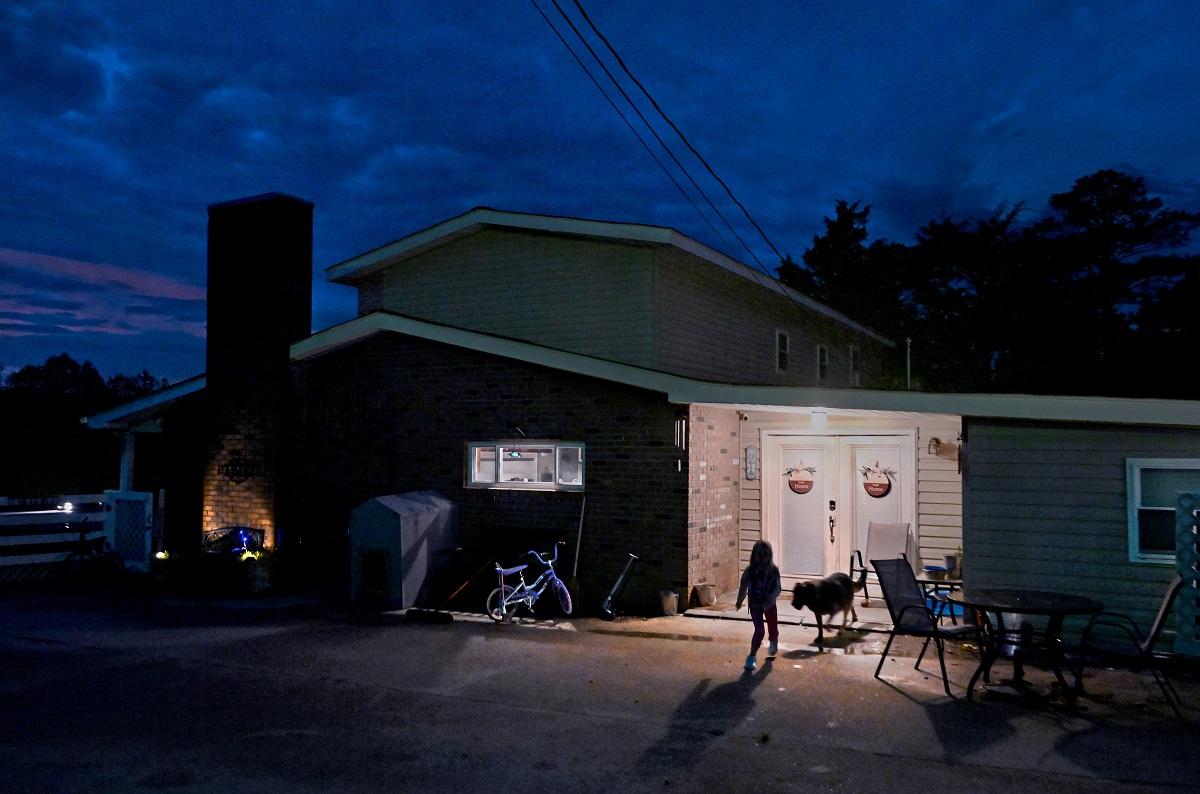
Celia Grace Hamlett (center) attends her brother’s baseball game with parents Gary and Kassie Hamlett in Winfield, Ala. in May.


15:35 JST, August 11, 2024
It’s the world’s most expensive drug: $4.25 million for a one-time infusion to stave off a rare neurodegenerative disease that can claim the lives of children by the time they turn 5.
But as the London-based pharmaceutical company Orchard Therapeutics prepares to offer the lifesaving treatment at a handful of U.S. hospitals this year, the eye-popping price tag is raising critical questions about patient access to a growing number of costly gene therapies in the fragmented U.S. health-care system.
The Food and Drug Administration approved the drug Lenmeldy in March, giving families of the roughly 40 to 100 U.S. babies born each year with metachromatic leukodystrophy (MLD), a genetic disease causing progressive decline in brain and motor functions, hope that their children would live into adulthood – if they can get the treatment.
In less than seven years, the number of single-dose gene therapies approved by the FDA grew from zero to 18, a number that analysts estimate will nearly quintuple by 2032. Such therapies modify a person’s genes to treat or cure disease. The list price for these treatments is projected to reach a total of $35 to $40 billion over the next decade, raising the stakes for drug manufacturers and policymakers to find a model for making these new medications accessible and affordable.
“The equity issues are huge with any individual gene therapy,” said Meghan Halley, an assistant professor of pediatrics at the Stanford Center for Biomedical Ethics.
In the rapidly expanding market of novel treatments for rare diseases, an array of hurdles make it difficult to administer specialty drugs such as Lenmeldy when patients would most benefit. The drugmaker and doctors say the treatment is most effective if given before symptoms arise, but the vast majority of newborns aren’t screened for the genetic disorder. Only five hospitals in the country are likely to offer the infusion, according to the manufacturer, forcing many patients to travel far from home. And how insurers will pay for the costly treatment has yet to be fully fleshed out.
“This is something we’re going to have to figure out because it’s coming for more and more rare diseases,” said Amy Gaviglio, who owns a Minneapolis-based genetics consulting business focused on rare diseases and newborn screening.
Accessing the world’s most expensive drug
The medication – and its price tag – underscores the broader tensions of determining costs for complex medicines that can save people’s lives.
The Institute for Clinical and Economic Review, a nonprofit that specializes in analyzing the value of drugs, recommended Lenmeldy be priced between $2.3 million and $3.9 million in a report last fall.
The drugmaker’s $4.25 million price tag came in “substantially above” ICER’s range, said David Rind, the group’s chief medical officer. Drug companies set their own prices and an array of factors – such as whether there’s a similar therapy already on the market – go into calculating the cost.
But the staggering price of Lenmeldy has not been met with the usual fierce backlash from experts known for their tough critiques of the pharmaceutical industry. It treats a rare disease, so the price would need to be set relatively high for the company to profit from the limited number of patients expected to be eligible for the drug, according to Rind.
“You’re taking kids who are going to die horribly, and you’re probably fixing them,” he said. “That’s worth a lot of money.”
MLD is caused by a deficiency of an enzyme called arylsulfatase A, which leads to a buildup of fatty substances that can be toxic to the nervous system. Children with the most common type of the disorder typically lose the ability to walk and talk. As the disease progresses, they can have trouble swallowing. They may need a feeding tube in their stomach or through their nose. Their limbs often become stiff and uncomfortable.
Lenmeldy essentially replaces the defective gene. Cells from the child are collected at a hospital, then shipped to a manufacturing site in Italy, where they are genetically modified to include functional copies of the flawed gene.
Bobby Gaspar, chief executive of Orchard Therapeutics, defended the company’s pricing.
“It really does come down to what is currently available for this disease … there’s nothing available for these children,” Gaspar said in an interview, adding that the drug doesn’t just extend life but improves its quality.
Yet, Lenmeldy’s price tag raises questions about how private and public insurers will pay for the drug. Private plans are evaluating coverage decisions, according to James Swann, a spokesperson for AHIP, the major insurance lobby. And since only five hospitals will offer the drug, state Medicaid programs must hammer out how to cover the therapy when it’s only available in another state, experts said.
Orchard Therapeutics is “committed to making sure there is access” to the drug, Gaspar said. The company plans to offer flexible payment options to insurers and outcomes-based contracts. Under such arrangements, insurers typically pay more when a drug works and get money back when it doesn’t.
The FDA does not consider the potential price of a drug when deciding whether to approve a medication. Its mandate is a different one: to consider the quality, safety and efficacy of a treatment.
But that hasn’t stopped federal regulators from grappling with what they can do to help drive down the costs of high-priced gene therapies.
“You can expect these days that the price tag will be in the million-plus range. … We’re not angry at the manufacturer per se,” said Peter Marks, director of the FDA’s Center for Biologics Evaluation and Research. “We need to do what we can to change the ecosystem to try to make it more efficient” to develop these treatments.
The agency recently launched a pilot program giving manufacturers of gene therapies for rare diseases easier access to FDA staff – a bid to quickly address questions such as how to better develop clinical trials, in an attempt to expedite drug development.
A deadly diagnosis
Celia Grace Hamlett was not quite 3 when doctors discovered an abnormal mass of tissue in her gallbladder that was associated with MLD. By 4, the child was fighting for her life at a Minneapolis hospital roughly 1,000 miles away from her Alabama home. She underwent a grueling course of chemotherapy to remove cells from the bone marrow so they could be replaced with modified ones. On Sept. 27, 2021, Celia Grace received an infusion of several small bags of new cells, becoming the first person in the United States to get the experimental gene therapy years before federal regulators officially approved the treatment.
M Health Fairview Masonic Children’s Hospital, where Celia Grace stayed one month, is one of the five hospitals planning to offer Lenmeldy. The other treatment centers are expected to be in Atlanta, Philadelphia, Houston and San Francisco, according to Orchard Therapeutics.
“It’s a very rare disease, and it doesn’t make sense to offer [the drug] 50 different places,” said Paul Orchard, a pediatric hematologist at M Health Fairview who isn’t affiliated with the drugmaker.
Yet, that means the vast majority of patients will need to uproot their lives to get the therapy, he said.
Now 7, Celia Grace showed off her Barbie dolls and a litter of 2.5-week-old Shepadoodle puppies during a recent video call. Her blonde hair, which she had lost during chemo, was sticky with sweat from playing outside.
“We don’t know why we were chosen to be the first family, but I just know we’re thankful that we were,” said Kassie Hamlett, Celia Grace’s mother.
Celia Grace and her parents plan to drive back to Minnesota in September for several days of follow-up appointments with specialists. She will undergo vision and neuropsychological tests as well as scans of her bones and brain. So far, doctors have not seen any progression of the disease during her annual checkups.
Orchard Therapeutics said that it has more than a dozen years of follow-up data from the earliest patients treated in clinical trials and that it will continue to collect data as patients get older. When the FDA approved the drug, federal regulators wrote that it “significantly reduced the risk of severe motor impairment or death” compared with children who went untreated.
Clinical trial data has shown that all children with the late infantile form of the disease who had not shown symptoms but were diagnosed through genetic testing and received the drug were alive at age 6. In comparison, 58 percent of children with the disease who had not been treated with the drug survived to 6.
Yet, it is difficult to diagnose the disease in time for the drug to be most effective, several doctors said. Federal regulators approved Lenmeldy for patients with the late infantile form of the disease – the most common and most aggressive type – who don’t yet have symptoms as well as for those with an early juvenile form who may or may not show symptoms.
In many instances, families only discover their child has MLD after they start to lose motor skills. Other times, a younger child is diagnosed through genetic testing once an older sibling shows signs of the disorder.
Stephanie Keller, a pediatric neurologist with Children’s Healthcare of Atlanta, estimated that she has seen just two or three patients in the last five years who would qualify for Lenmeldy, in part because doctors aren’t equipped to diagnose the condition when there are no symptoms.
There’s an effort underway to change that.
Doctors and patient advocacy groups submitted an application in June to a federal advisory committee to nominate MLD as a condition for which all newborns are screened. The decision is ultimately up to individual states, although most follow federal guidelines.
For some MLD patients, bone-marrow transplants can be beneficial, researchers say.
John Wright started to complain that his legs hurt in 2018 when he was 5 years old and began limping. By the time he was diagnosed with MLD later that year, the disease was too advanced for the Maryland kindergartner to qualify for Lenmeldy’s clinical trial in Italy. He instead received a bone-marrow transplant in North Carolina.
Doctors tested his younger siblings for the genetic condition. His brother Andrew, then 3, tested positive and was quickly accepted into the clinical trial to receive the drug.
Both boys have received positive reports from their doctors during follow-up appointments. Amy Wright, the boys’ mother, said she believes the bone-marrow transplant has substantially extended now-11-year-old John’s life. Andrew, now 9, is not showing signs of the disease; Wright said Andrew’s doctors are careful not to use the word “cured” given that the medication is so new.
“I worry about MLD every day of my life,” Wright said. “Initially it was almost paralyzing, but now, since treatment, it’s brought hope.”
"News Services" POPULAR ARTICLE
-

American Playwright Jeremy O. Harris Arrested in Japan on Alleged Drug Smuggling
-

Japan’s Nikkei Stock Average as JGB Yields, Yen Rise on Rate-Hike Bets
-

Japan’s Nikkei Stock Average Licks Wounds after Selloff Sparked by BOJ Hike Bets (UPDATE 1)
-

Japanese Bond Yields Zoom, Stocks Slide as Rate Hike Looms
-

Japan’s Nikkei Stock Average Buoyed by Stable Yen; SoftBank’s Slide Caps Gains (UPDATE 1)
JN ACCESS RANKING
-

Keidanren Chairman Yoshinobu Tsutsui Visits Kashiwazaki-Kariwa Nuclear Power Plant; Inspects New Emergency Safety System
-

Imports of Rare Earths from China Facing Delays, May Be Caused by Deterioration of Japan-China Relations
-

University of Tokyo Professor Discusses Japanese Economic Security in Interview Ahead of Forum
-

Japan Pulls out of Vietnam Nuclear Project, Complicating Hanoi’s Power Plans
-

Govt Aims to Expand NISA Program Lineup, Abolish Age Restriction
























